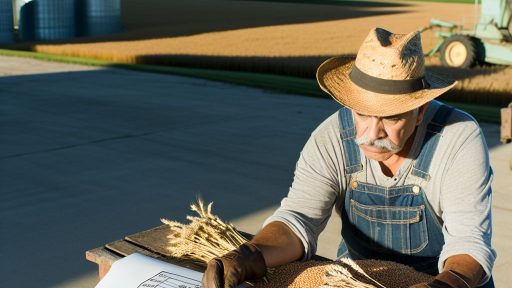Introduction to Research and Development Funding in Agriculture
Research and development funding plays a crucial role in modern agriculture.
It supports innovation, enhances productivity, and ensures sustainability.
Farmers rely on these funds to improve their techniques and technologies.
Various funding sources are available to assist agricultural stakeholders.
Understanding these options is essential for successful applications.
Types of Research and Development Funding
Funding for agriculture can come from public and private sectors.
Government grants often provide substantial financial support.
Non-profit organizations also offer funding sources aimed at innovation.
Private sector investments focus on commercialization and practical applications.
Each funding type has its specific goals and requirements.
Importance of R&D in Agriculture
Research and development drive advancements in farming practices.
They lead to the development of new technologies and crop varieties.
Moreover, R&D helps in addressing challenges such as climate change.
Farmers can implement research findings to boost efficiency.
This, in turn, enhances profitability and sustainability.
Transform Your Agribusiness
Unlock your farm's potential with expert advice tailored to your needs. Get actionable steps that drive real results.
Get StartedEligibility and Application Process
Eligibility criteria for R&D funding varies across different programs.
Farmers should carefully review these criteria before applying.
Applications typically require a detailed project proposal.
This proposal should outline the objectives and anticipated outcomes.
Additionally, timelines and budgets must be clearly defined.
Tips for Securing Funding
Start by identifying the right funding sources for your research.
Networking with other farmers and agricultural experts can provide insights.
Attend workshops or forums focused on agricultural funding opportunities.
Craft a compelling narrative in your proposal to capture interest.
Lastly, ensure your project aligns with current agricultural trends and priorities.
Understanding the Importance of R&D Funding for Farmers
Driving Innovation
R&D funding fuels innovation in agriculture.
It enables farmers to implement new technologies.
Consequently, they can increase their productivity.
Moreover, innovative practices can enhance sustainability.
Farmers who invest in R&D often see better yields.
Boosting Competitiveness
Competitive funding allows farmers to stay ahead in the market.
With access to advanced research, they improve their products.
This leads to higher quality produce.
In turn, this boosts their market position.
Thus, funding plays a critical role in maintaining competitive advantage.
Pandemic Resilience
R&D funding enhances resilience against unpredictable challenges.
For instance, it helps farmers adapt to climate change impacts.
It also provides resources to combat agricultural diseases.
Adaptation strategies become more effective with ongoing research.
Showcase Your Farming Business
Publish your professional farming services profile on our blog for a one-time fee of $200 and reach a dedicated audience of farmers and agribusiness owners.
Publish Your ProfileFarmers equipped with knowledge and tools can better navigate crises.
Enhancing Food Security
Investing in agricultural research directly impacts food security.
Such funding supports efforts to increase food production.
It helps develop crops that withstand harsh conditions.
As a result, the community benefits from more stable food supplies.
Food security is essential for a healthy and thriving society.
Attracting External Investment
Securing R&D funding can attract additional private investments.
This funding signals to investors that agriculture is forward-thinking.
As a consequence, businesses may partner with innovative farmers.
Such collaborations amplify growth opportunities.
Ultimately, this creates a vibrant agricultural ecosystem.
Types of R&D Funding Available for Agricultural Projects
Government Grants and Subsidies
Government agencies offer various grants for agricultural R&D.
These funds often support innovative projects that enhance productivity.
Farmers may find federal, state, or local funding opportunities.
Grants require thorough applications that detail project plans.
Successful applicants demonstrate potential for impact and sustainability.
Research Partnerships with Universities
Collaborating with universities can yield significant funding opportunities.
Many institutions seek partnerships to advance agricultural research.
Farmers can benefit from shared resources and expertise.
Joint projects might attract external funding from industry leaders.
Additionally, partnerships can lead to innovative solutions to pressing challenges.
Private Sector Investments
Some companies invest in agricultural R&D projects with promising returns.
Farmers can approach businesses that align with their goals.
Investors often look for projects that enhance efficiency or sustainability.
Establishing a compelling business case is crucial for attracting funding.
Furthermore, showcasing potential market demand can strengthen proposals.
Crowdfunding Platforms
Crowdfunding has emerged as a viable alternative for funding projects.
Farmers can use online platforms to reach a broad audience.
To succeed, they must clearly communicate their project goals.
A strong social media presence can help drive interest and funding.
Storytelling engages potential backers and encourages contributions.
Nonprofit Organizations and Foundations
Numerous nonprofits focus on supporting agricultural innovation.
These organizations often provide grants for specific initiatives.
Farmers should research foundations that align with their mission.
Applications commonly require detailed project outlines and budgets.
Success stories from previous funding recipients can enhance credibility.
Competitions and Challenges
Various organizations host competitions for agricultural innovations.
Winners often receive funding, mentorship, or resources.
Participation can elevate a project’s visibility within the industry.
Farmers should keep an eye out for competitions relevant to their work.
Showcase Your Farming Business
Publish your professional farming services profile on our blog for a one-time fee of $200 and reach a dedicated audience of farmers and agribusiness owners.
Publish Your ProfileCompelling proposals can significantly increase chances of success.
Discover More: Enhancing Farming Operations with Rural Development Policies
Identifying Potential Funding Sources
Government Grants
Government grants offer vital financial support to farmers pursuing research and development.
These grants often target specific agricultural innovations and sustainability projects.
Farmers should regularly check government websites for new grant opportunities.
For instance, the U.S. Department of Agriculture (USDA) provides various grant programs.
Each grant has specific eligibility requirements and application procedures.
Therefore, careful review of guidelines is essential before applying.
Local and State Programs
Local and state governments often have their own funding programs.
Farmers can benefit from initiatives aimed at improving local agriculture.
These programs may be more accessible than federal grants.
Farmers should reach out to local extension offices for information.
Networking with local agricultural organizations can reveal valuable resources.
Research Institutions and Universities
Many research institutions and universities offer funding for agricultural projects.
These funds often focus on innovative research that advances agricultural practices.
Collaborating with academic institutions can also enhance funding opportunities.
Farmers should explore partnerships with agricultural researchers and students.
Additionally, universities frequently host grant writing workshops.
Private Sector Funding
Private sector organizations may also provide grants or investment opportunities.
Many corporations support sustainable agriculture initiatives as part of their social responsibility.
Farmers can research companies that align with their projects and values.
Applying for private sector funding might involve rigorous application processes.
Building relationships with industry partners can open doors to funding opportunities.
Nonprofit Organizations
Numerous nonprofit organizations prioritize agricultural innovation and sustainability.
These organizations often offer grants tailored to specific agricultural challenges.
Farmers should investigate local, regional, and national nonprofit programs.
Nonprofits may have unique requirements compared to government grants.
Moreover, these organizations sometimes provide training and resources to applicants.
Find Out More: Rural Development Policy Insights for Today’s Farming Community
Leveraging Private Sector Investments in Farm Research
Understanding the Private Sector Landscape
The private sector plays a pivotal role in agricultural innovation.
Many companies are eager to invest in research and development.
Investors seek partnerships that demonstrate clear benefits.
Companies often look for projects that align with their goals.
This creates opportunities for farmers to access funding.
Identifying Potential Investors
Farmers must actively search for suitable investors.
Identify companies with an interest in agricultural advancements.
Consider local firms that focus on agri-tech innovations.
Explore initiatives from established corporations looking to diversify.
Networking events can help connect with potential investors.
Building Strong Partnerships
Successful partnerships begin with clear communication.
Showcase Your Farming Business
Publish your professional farming services profile on our blog for a one-time fee of $200 and reach a dedicated audience of farmers and agribusiness owners.
Publish Your ProfileFarmers should outline their research objectives clearly.
Articulate the benefits of the project to potential investors.
Trust and transparency will foster strong relationships.
Regular updates can reinforce investment confidence.
Crafting Compelling Proposals
A well-crafted proposal is crucial for attracting funding.
Start with a clear problem statement and project scope.
Include objectives that resonate with private sector interests.
Use data to support claims and projections effectively.
Make sure to highlight potential returns on investment.
Utilizing Government Grants and Incentives
Many governments offer grants that can supplement private funding.
Research available programs aimed at agricultural innovation.
Leverage these grants to attract further private investment.
Combine resources to maximize research capabilities.
This strategy can boost project viability and sustainability.
Measuring and Reporting Outcomes
Investors require measurable outcomes from their funding.
Establish key performance indicators at the project’s outset.
Regularly report on progress and outcomes.
Adjust strategies based on feedback and results.
This demonstrates accountability and strengthens future investments.
Engaging with Industry Associations
Joining industry associations can enhance funding opportunities.
These groups often facilitate connections between farmers and investors.
Participate actively in discussions and events.
Access valuable resources and knowledge from peers.
This engagement can lead to collaborative funding efforts.
You Might Also Like: Rural Development Policies: Key Drivers of Agricultural Innovation
How to Prepare a Competitive Grant Proposal for Agricultural Research
Understanding the Funding Landscape
The first step is to research available funding sources.
Explore government grants, private foundations, and academic partnerships.
Each funding source has specific requirements and priorities.
Understanding these will help you tailor your proposals.
Identifying Research Goals
Clearly define the goals of your research project.
Your objectives should align with the interests of potential funders.
Establish how your research will benefit agriculture and local communities.
This alignment enhances the appeal of your proposal.
Crafting a Detailed Project Plan
A detailed project plan is essential for a successful proposal.
This plan should outline your methodology, timeline, and expected outcomes.
Break down your project into manageable phases.
Include key milestones to track progress effectively.
Budgeting Appropriately
Develop a clear and comprehensive budget.
Your budget should reflect all potential expenses.
Include materials, labor, and overhead costs.
Showcase Your Farming Business
Publish your professional farming services profile on our blog for a one-time fee of $200 and reach a dedicated audience of farmers and agribusiness owners.
Publish Your ProfileMake sure your budget aligns with the funding source’s guidelines.
Writing the Proposal
Begin writing your proposal by following a clear structure.
Include an executive summary that captures attention.
Make sure to present a compelling narrative throughout.
Use data and evidence to support your claims.
Keep your language clear and concise to enhance readability.
Reviewing and Editing
After completing your draft, conduct a thorough review.
Check for clarity, grammar, and adherence to the guidelines.
Consider seeking feedback from trusted colleagues.
Multiple perspectives can enhance the quality of your proposal.
Submitting the Proposal
Prepare all necessary documents for submission.
Follow the funding organization’s submission process carefully.
Meet all deadlines to avoid disqualification.
Ensure that all formats and specifications are met.
Follow-Up Strategies
Once submitted, follow up with the funding organization.
This might involve asking about the review timeline.
Be prepared to provide additional information if requested.
Your proactive approach can leave a positive impression.
Explore Further: Key Legal Changes Affecting Agriculture Today

Building Partnerships with Research Institutions for Funding Opportunities
Understanding the Importance of Collaboration
Collaboration with research institutions is vital for securing funding.
It leverages mutual strengths and helps develop innovative solutions.
Moreover, partnerships can lead to increased visibility for farmers’ projects.
Identifying Potential Research Institutions
Begin by researching local universities and agricultural colleges.
Many of these institutions offer dedicated programs for agricultural research.
Additionally, consider non-profits focused on agricultural advancements.
Use online resources to find institutions that align with your goals.
Establishing Initial Contact
Prepare a compelling introduction to your project or idea.
Clearly outline the mutual benefits of a potential partnership.
Connect through email or professional networking platforms.
Follow up with a phone call to express your interest.
Creating a Strong Proposal
Your proposal should outline your funding needs clearly.
Include objectives, potential impact, and partnership benefits.
Additionally, provide a timeline for project completion.
Ensure it aligns with the research institution’s goals and interests.
Maintaining the Partnership
Regular communication fosters a successful collaboration.
Schedule periodic meetings to discuss progress and challenges.
Share findings and celebrate successes together.
Moreover, be open to feedback and adjustments as needed.
Exploring Funding Sources Together
Collaboratively identify funding sources that align with your project.
Research grants available through government and private foundations.
Showcase Your Farming Business
Publish your professional farming services profile on our blog for a one-time fee of $200 and reach a dedicated audience of farmers and agribusiness owners.
Publish Your ProfileAdditionally, consider partnerships with biotech firms for sponsorship.
Utilize the institution’s experienced grant writers when applying.
Best Practices for Managing and Reporting on R&D Funds
Establish Clear Objectives
Set specific goals for your R&D project.
These objectives guide your funding efforts.
Ensure they align with overall farm strategies.
This alignment maximizes the chances of success.
Develop a Detailed Budget
Create a comprehensive budget for your R&D activities.
Include all projected costs associated with the project.
This includes labor, materials, and overhead expenses.
Review this budget regularly to track expenditures.
Maintain Accurate Records
Keep detailed and organized records of all transactions.
This documentation supports your funding reports.
Utilize digital tools for efficient record-keeping.
Maintain receipts and invoices for all purchases.
Regular Reporting to Stakeholders
Provide updates to funders on R&D progress.
Include both financial and project status reports.
Transparency fosters trust and ongoing support.
Schedule these reports at regular intervals.
Communicating Successes and Challenges
Share both achievements and obstacles encountered.
This open communication strengthens relationships with funders.
It also enhances the credibility of your project.
Leverage Technology and Software
Utilize project management software for tracking tasks.
These tools streamline communication among team members.
Additionally, some software includes budgeting features.
Employ these resources to stay organized and efficient.
Engage with Funding Organizations
Build relationships with potential funders early on.
Attend workshops and networking events in your field.
This engagement can lead to new funding opportunities.
Stay informed about their current funding priorities.
Evaluate and Adjust Your Approach
Regularly assess the effectiveness of your funding strategies.
Be flexible and willing to make necessary changes.
Gather feedback from your team and stakeholders.
Use this information to improve future proposals.
Case Studies: Successful R&D Funding Strategies by Innovative Farmers
Utilizing Grant Opportunities
Maria Thompson successfully secured a grant from the Agricultural Research Service.
She used the funds to research sustainable pest control methods.
This innovative approach helped her reduce pesticide use by 30%.
Moreover, it increased the resilience of her crops against pests.
Maria’s approach highlights the importance of leveraging grant opportunities.
Partnering with Educational Institutions
James Chen formed a partnership with a local university.
His collaboration focused on developing drought-resistant crop varieties.
Showcase Your Farming Business
Publish your professional farming services profile on our blog for a one-time fee of $200 and reach a dedicated audience of farmers and agribusiness owners.
Publish Your ProfileThis partnership allowed him access to advanced research facilities.
Consequently, James was able to conduct experiments on a larger scale.
Working with academia also helped him attract additional funding.
Engaging the Community
Susan Martinez organized community workshops to promote regenerative farming.
Through these workshops, she gathered support from fellow farmers.
This engagement led to a collective funding application to a regional initiative.
As a result, they received funding for soil health improvement projects.
Community involvement has proven essential in securing financial aid.
Leveraging Technology
Eduardo Garcia utilized precision agriculture technology in his R&D efforts.
By adopting drones and soil sensors, he improved crop monitoring.
This technology enhanced data collection, leading to innovative farming methods.
Eduardo’s strategy attracted the attention of tech-focused investors.
His approach exemplifies the fusion of technology and agriculture.
Building a Strong Business Case
Linda Morrison developed a clear business plan targeting investors.
Her focus on the economic benefits of her R&D initiatives was compelling.
She emphasized potential returns on investment for stakeholders.
Linda’s structured approach resulted in significant funding from venture capitalists.
A strong business case remains crucial for attracting financial support.
Future Trends in R&D Funding for Agriculture and Implications for Farmers
Emerging Funding Sources
Farmers are witnessing a rise in alternative funding sources.
Public-private partnerships are gaining traction.
These partnerships provide shared resources and knowledge.
Additionally, crowdfunding is becoming a viable option.
Farmers can access support from individual donors and investors.
This shift allows for diverse project development.
Moreover, grants from private foundations are increasing.
These grants often focus on innovative practices.
Technological Advancements in Funding Applications
Advancements in technology simplify the funding application process.
Farmers can now leverage online platforms for submissions.
This streamlines communication with funders.
Furthermore, data analytics helps applicants stand out.
Analyzing trends can lead to tailored project proposals.
In addition, digital tools enhance collaboration among stakeholders.
This allows for effective sharing of research and outcomes.
Emphasis on Sustainability and Climate Resilience
Funding agencies are prioritizing sustainability-oriented projects.
Farmers should align their proposals with these goals.
Projects focusing on climate resilience are increasingly favored.
Funding for regenerative practices is expanding.
By implementing sustainable methods, farmers can attract more support.
Moreover, integrated pest management is gaining attention.
Innovations in water management are also essential.
Showcase Your Farming Business
Publish your professional farming services profile on our blog for a one-time fee of $200 and reach a dedicated audience of farmers and agribusiness owners.
Publish Your ProfileCollaboration and Multi-Disciplinary Approaches
Collaborative efforts enhance the success of funding applications.
Farmers can partner with researchers and institutions.
This collaboration fosters innovative solutions for pressing challenges.
Multi-disciplinary teams often yield comprehensive project ideas.
Networking within agricultural communities is crucial.
Shared knowledge leads to better project execution.
Consequently, collaborative proposals have higher success rates.
Continued Education and Training
As funding trends evolve, education remains vital.
Farmers should stay updated on funding opportunities.
Participating in workshops and training sessions enhances skills.
These educational events boost confidence in proposal writing.
Staying informed about agricultural research trends is essential.
Farmers can benefit from engaging with experts in the field.
This ensures that their projects are relevant and impactful.
Additional Resources
Guide for the Care and Use of Laboratory Animals, 8th edition …




